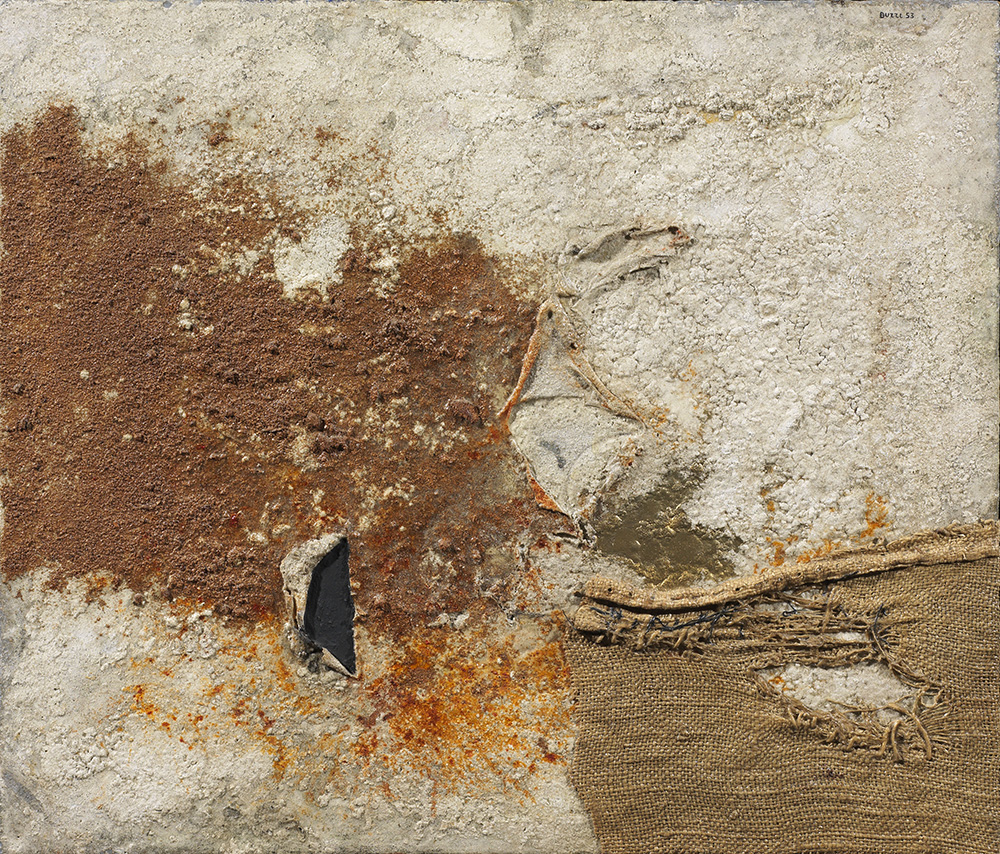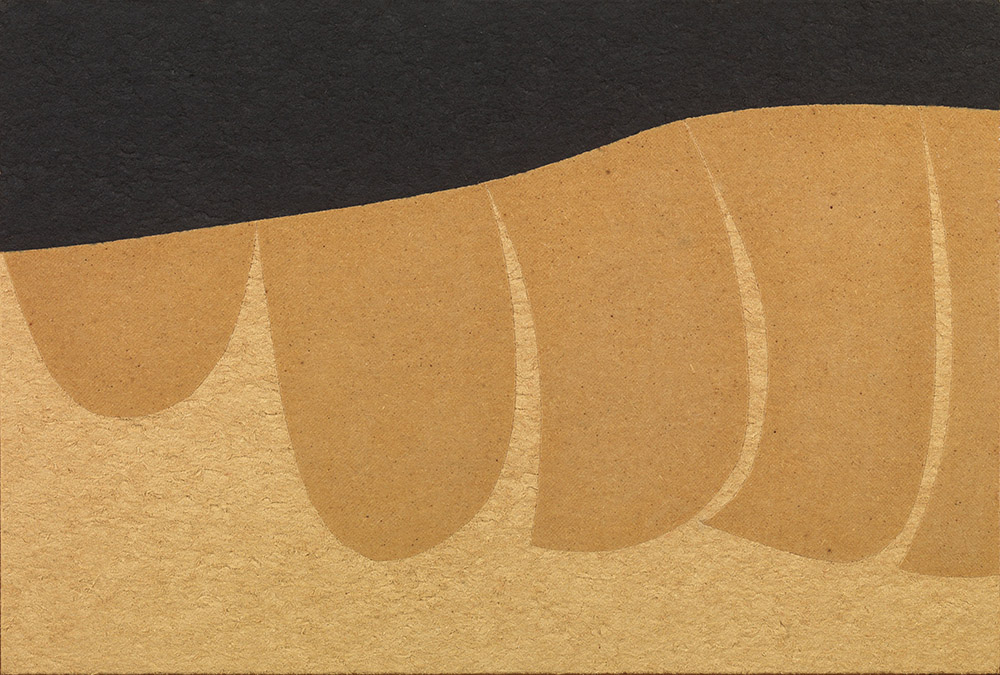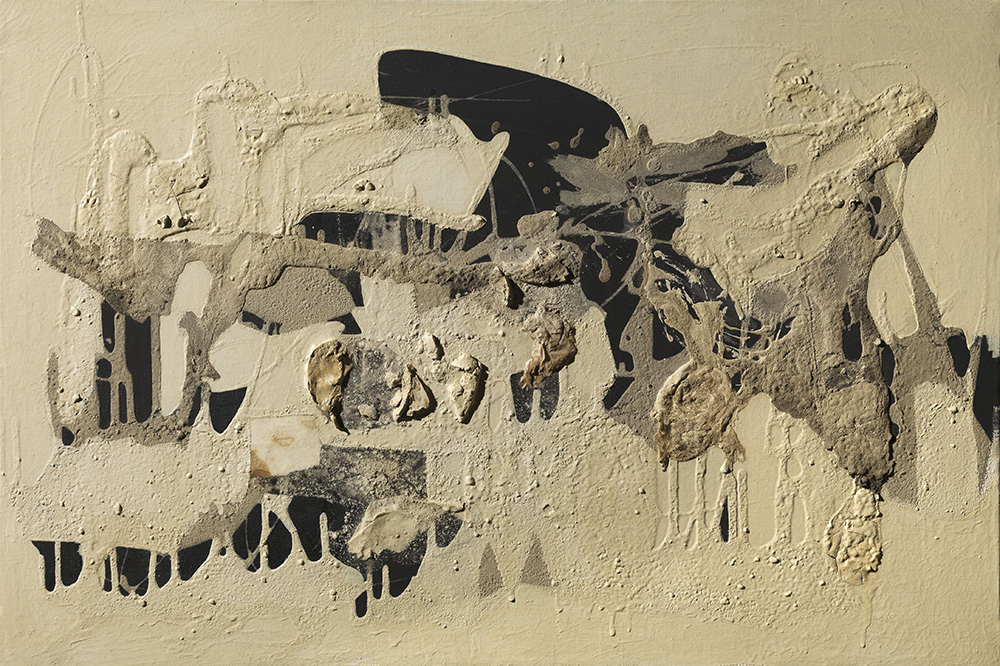ART-TRIBUTE:Alberto Burri
 Alberto Burri was a master of 20th Century art, his works successfully blur the line between painting and sculpture. As a result of his interest in materiality, the artist’s figurative work often investigates the use of non-traditional materials such as burlap, wood, tar, plastic, and zinc oxide. Burri’s unorthodox technique placed the artist at the forefront of an international wave of younger artists who also pushed at and beyond the perimeters of painting by introducing unconventional materials and techniques.
Alberto Burri was a master of 20th Century art, his works successfully blur the line between painting and sculpture. As a result of his interest in materiality, the artist’s figurative work often investigates the use of non-traditional materials such as burlap, wood, tar, plastic, and zinc oxide. Burri’s unorthodox technique placed the artist at the forefront of an international wave of younger artists who also pushed at and beyond the perimeters of painting by introducing unconventional materials and techniques.
By Dimitris Lempesis
Photo: Tornabuoni Art Archive
With more than 30 works, and exploring more than 50 years of artistic production, the exhibition of the radical work of Alberto Burri, that is on presentation at Tornabuoni Art in Paris, gathers works from eight of his most iconic series: the “Catrami”, “Muffe”, “Sacchi”, “Legni”, “Ferri”, “Plastiche”, “Cretti” and “Cellotex”. More than forty years after the last exhibition dedicated to Alberto Burri in France (the most recent was held at the Musée National d’Art Moderne in 1972), the retrospective charts the entirety of Burri’s productive output, from pieces made immediately after his release from the prisoner-of-war camp in Texas in 1946, to his final works from the early 1990s. Alberto Burri was born 12/3/1915, in Città di Castello, a small town in the Umbria region of Italy. In 1940 he received a degree in medicine from the Università degli Studi di Perugia. He served in the Ethiopian campaign and in World War II, first as a frontline soldier and then as a physician. Following his unit’s May 1943 capture in Tunisia, Burri was sent to a prisoner-of-war camp in Hereford, Texas. Disaffected by war and by his internment, he took up painting in an autodidactic, figurative style and never practiced medicine again. In February 1946, Burri was repatriated to Italy and set up a studio in Rome. Burri made his first trip to Paris in 1948–49, where he saw the tar-paper collages of Joan Miró and figurative paintings with coarse, bituminous backgrounds by Jean Dubuffet. Upon his return to Rome, Burri began to experiment with his first signature material: pitch-black tar. He mixed it with heated oil paint, black enamel, and ground pumice stone to create the “Catrami”, a group of around thirty works that date to 1948–52. They announced the artist’s method of working with one dominant material to create various textures and gradations of relief. He scored and gouged through the dense, sticky paste, and poured liquid tar into gooey puddles or forced it to dry in crusty patches. The “Muffe” are named for their visual effects rather than for a material per se. They display mud-colored lumps and layers of sludge that resemble bacterial invasion, soil, or excrement. “Muffe” is the generic term for the many types of fungal spores that germinate in humid conditions. Burri approximated the look of mold by mixing ground pumice stone with paint, mineral particles, and synthetic resins. The clusters appear to fester in a state of simultaneous growth and decay, wreaking havoc on the painting surface. The fully abstract Muffe are more like dirt paintings: the agglomerations of pumice visibly weigh down the canvas without poetry or existential drama. Piled high in relief, certain works bring to mind topographical maps or the arid landscapes familiar to the artist from his time in East and North Africa and the Texas Panhandle. In 1950 Burri made his first “Sacco” from a cast-off burlap bag mounted on a stretcher. During his time in a Texas prisoner-of-war camp (1943-46), the artist had used found gunnysacks as canvases for figurative paintings. In the “Sacchi” series, the unpainted burlap functions as both support and ground. Form, line, color, and tone emerge from the textile’s warp and woof, stains, patches, and stitches. Burlap is produced with jute, a coarse fiber related to the finer linen used for artists’ canvases. As a result, the worn and tattered material looks like a traumatized version of a traditional canvas. When the Sacchi were first exhibited in Rome in 1952, one critic described them as paintings but “impoverished, rotted, consumed, and already wasted away”. Burlap was ubiquitous on the front lines during World War II, and used for supply sacks, sandbags, and camouflage. The Sacchi, however, respond to the historical context of postwar Italy as an impoverished country dependent on the charity of the United States. A few of the gunnysacks Burri employed had carried foodstuffs from America’s Marshall Plan relief effort (1948–53), but most came from the flour mill in his hometown. The worn burlap attests to use by different hands as well as to the artist’s own laborious stitching. Lacerated and threadbare, the material evinces anger and shame but also vulnerability and dignity. In the mid-1950s Burri adopted materials essential to the building industry and to Italy’s postwar reconstruction. Instead of giving new life to fabric remnants, he repurposed pristine wood veneer, sheet metal, plastic sheeting, and insulation board. He also developed a new process of burning materials, which he called combustion. The Surrealists had invented soot drawing, or fumage, in the 1930s, but Burri was precocious in his mastery of fire as a full-fledged painterly technique. The “Legni” are composed of thin laminates, usually of birch or oak, meant to replicate expensive hardwood furniture and wall paneling. With the flame of an oxyacetylene torch, the artist buckled the golden-hued surfaces, painted brooding shadows, and carved jagged-edged holes. The veneer’s association with human shelter adds to the searing power of the charred passages. The “Ferri” of 1958–61 are made of cold-rolled steel straight from the mill. Modernist artists had previously assembled found-metal objects or welded iron into three-dimensional figures and abstract geometries. Burri’s innovation was to cut and join the sheets into austere reliefs, nail them to a support, and hang them on the wall as a form of industrial monochrome. Factory marks and inscriptions function as graphic and coloristic flourishes. The artist “stitched” the metal planes together with a welding rod and torch, forming seams of weld beads and slag. By varying the heat of the flame, he produced blue, brown, purple, and yellow tones (known as temper colors) on the steel canvases. The Ferri tilt out precariously and bear down on the viewer, vaunting their raw power and the risk involved in drawing too near. As Italy’s era of reconstruction ended in the late 1950s and the nation experienced an economic boom, Burri began to experiment with industrial plastic sheeting. Distributed in large rolls, it was primarily used for packaging and tarpaulins. Each type of plastic adopted by Burri has a slightly different speed of combustion. The red and transparent works are made with polyvinyl chloride (PVC) and the black examples from polyethylene (PE). Using torches and lamps to melt the plastic, he draped and sculpted it; once cooled, it retained its new shape. He often encased the whole in another translucent membrane and fashioned visible air pockets, or voids within voids. Burri harnessed the material’s thermoplastic properties to create a new hybrid of the painterly and the sculptural with unnatural textures that make the plastic seem both inert and strangely alive. The “Combustioni plastiche” exemplify Burri’s means of finding beauty where one would least expect it—in mass-produced, disposable things. The “Cretti” were inspired in part by the parched landscape of Death Valley; Burri and his wife, Minsa Craig, resided in Los Angeles during the winters from 1963 until 1991. But the series’ origins lie in a technique the artist had been exploring since 1948: inducing craquelure, the fine cracks one sees on aging paintings. The “Cretti” are made with a traditional artist’s pigment, zinc white, which forms a brittle paint film prone to cracking if not mixed with proper amounts of binder. Exploiting what other artists consider a limitation, Burri deliberately prompted some of the widest and deepest craquelure in the history of art. He encouraged the ground to fissure in patterns and helter-skelter episodes over a period of hours or days, depending on the amounts of water and binder in the admixture and the thickness of its application. The “Cellotex” compositions, in contrast to the “Cretti”, are precisely determined. Burri had employed Celotex insulation board as a support intermittently throughout his career (the brand name is spelled with one l, while Burri used two in his titles). Now he scored through the surface, exposed the fibrous interior, and peeled back layers to form planes of barely perceptible relief. For the most part Burri worked in monochrome: with either the prefabricated ocher color of the fiberboard or layers of black paint. Many “Cellotex” were conceived as multipartite narrative cycles, each panel a different iteration of a given set of shapes. The late works revisit the geometric and biomorphic motifs and pitch-black color of the Catrami, affirming Burri’s retrospective view of his career: “My last picture is the same as the first”.
Info: Tornabuoni Art, Passage de Retz, 9 rue Charlot, Paris, Duration 19/10-22/12/18, Days & Hours: Tue-Fri 10:30-18:30, Sat 11:00-19:00, www.tornabuoniart.fr






